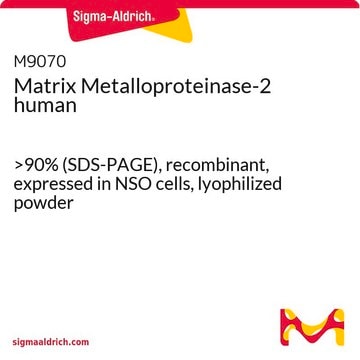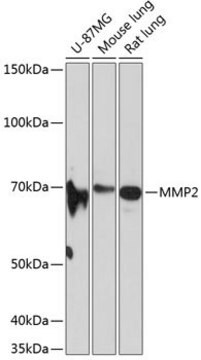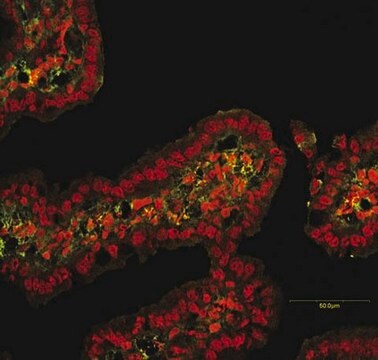MAB3308
Anti-MMP-2 Antibody, a.a. 468-483 hMMP2, clone 42-5D11
clone 42-5D11, Chemicon®, from mouse
Synonym(s):
Gelatinase A, 72 kDa Type IV Collagenase
About This Item
Recommended Products
biological source
mouse
Quality Level
antibody form
purified antibody
antibody product type
primary antibodies
clone
42-5D11, monoclonal
species reactivity
rat, bovine, human, rabbit, horse, mouse, pig
manufacturer/tradename
Chemicon®
technique(s)
ELISA: suitable
immunohistochemistry: suitable (paraffin)
western blot: suitable
isotype
IgG1κ
NCBI accession no.
UniProt accession no.
shipped in
dry ice
target post-translational modification
unmodified
Gene Information
human ... MMP2(4313)
General description
MMP2, also known as Gelatinase A, is a type IV collagenase that specifically cleaves type IV collagen, the major structural component of basement membranes. The metastatic potential of tumor cells has been found to correlate with the activity of this enzyme.
Specificity
Immunogen
Application
Immunohistochemistry on frozen and paraffin-embedded tissues using PLP fixation: 1-5 μg/mL (has not been tested in traditional formalin fixed tissues)
ElA
Cell Structure
MMPs & TIMPs
Target description
Physical form
Storage and Stability
Analysis Note
Lung, nerve, and various soft tissue tumors
Other Notes
Legal Information
Disclaimer
Unless otherwise stated in our catalog or other company documentation accompanying the product(s), our products are intended for research use only and are not to be used for any other purpose, which includes but is not limited to, unauthorized commercial uses, in vitro diagnostic uses, ex vivo or in vivo therapeutic uses or any type of consumption or application to humans or animals.
Not finding the right product?
Try our Product Selector Tool.
Storage Class
12 - Non Combustible Liquids
wgk_germany
WGK 2
flash_point_f
Not applicable
flash_point_c
Not applicable
Certificates of Analysis (COA)
Search for Certificates of Analysis (COA) by entering the products Lot/Batch Number. Lot and Batch Numbers can be found on a product’s label following the words ‘Lot’ or ‘Batch’.
Already Own This Product?
Find documentation for the products that you have recently purchased in the Document Library.
Our team of scientists has experience in all areas of research including Life Science, Material Science, Chemical Synthesis, Chromatography, Analytical and many others.
Contact Technical Service








